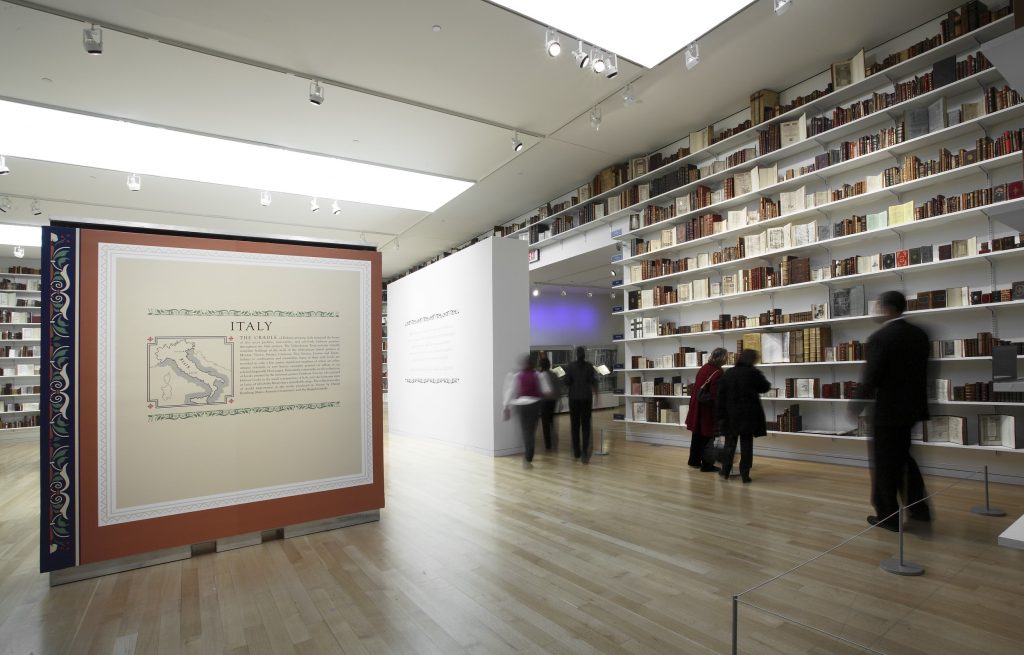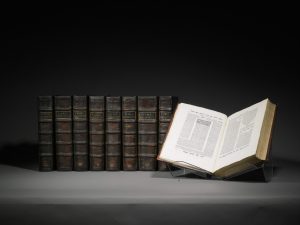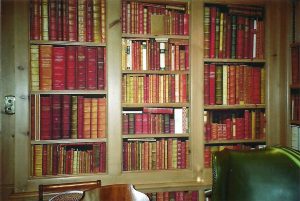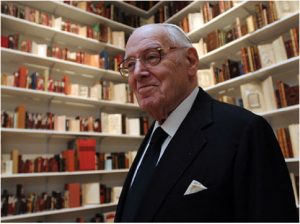The Custodian

Sotheby’s exhibited the library in a magnificent floor-to-ceiling display. Photos courtesy of Sotheby’s
In his four decades at Sotheby’s, the renowned auction house, David Redden presided over many memorable sales.1 Among the most notable, he lists the estate of Jacqueline Kennedy Onassis, the Duchess of Windsor’s jewels, a lunar lander, and a copy of the Magna Carta. But the one that touched him the most was the sale of an extraordinary collection of rare Hebrew printed books, assembled by Jack Lunzer, z“l, whose first yahrtzeit will be observed in Kislev of this year.
Known as the Valmadonna Trust Library, the collection consisted of over 13,000 printed books and manuscripts, and is considered the twentieth century’s greatest and finest collection of Judaica in private hands.
Among its principal treasures were a Chumash from 1189, the only surviving Hebrew manuscript written in England before the expulsion of the Jews in 1290; a complete Babylonian Talmud, produced by the renowned early sixteenth-century Christian printer Daniel Bomberg; and more than one-third of all known Hebrew incunabula (i.e., the earliest printed books, dating from the last quarter of the fifteenth century).2
Lunzer, who died last year aged ninety-two, was born in Antwerp but as a young man spent much time in Italy, where his wife Ruth hailed from. He named his library after the town of Valmadonna in Tuscany, of which he and Ruth were very fond.3 He put the library into the trust for the benefit of his family.
Jack and Ruth lived in London, where he built up a major business in industrial diamonds, securing monopolies in several West African countries.4 As he traveled the world on business, he began to seek out and acquire rare Hebrew books wherever they could be found.
“He always loved beautiful things,” says Margaret Rothem, the eldest of the Lunzers’ five daughters. “I remember when he first began to teach me to daven, he pulled out a lovely calligraphed piece of artwork inscribed with ‘Da lifnei mi atah omed’ (‘Be aware of before Whom it is that you are standing’).”
Jack Lunzer’s younger sister Joan Lau-Lavie concurs. “Jack was born in the wrong generation,” she says. “He was an aesthete; he loved beauty of form, beautiful books, beautiful paper, beautiful pens.”
The books themselves are things of beauty. As they arrived from dealers and auction houses around the world, each volume was checked and then sent out to be elegantly rebound in rich and colorful leather. Besides the title, the spines also identify the date and place of printing, reflecting the spread of the Hebrew press around the globe in Italy, Holland, England, Greece, Eastern Europe, the Ottoman Empire, North Africa, India and China.
After Ruth passed away in 1978, it was the library that kept Lunzer going. It became his passion, and filled the house. Some volumes were nestled behind wire-mesh and glass in custom-built bookcases; others were crammed three-deep in nooks and crannies. You would find shelf upon shelf of Chumashim, Mikra’ot Gedolot, the Talmud and its commentaries, and rabbinic literature, as well as machzorim, haggadot and all types of Jewish liturgy according to various rites. Many of these volumes were exceedingly rare, or perhaps the only extant copy of a particular printing.
Margaret told her husband, when she was pregnant with one of their children, “If it’s a boy, we should name him Daniel Bomberg, because then my father will dote on him.”
Lunzer enjoyed, and always wanted to share, the finer things in life. For many years, there was a minyan in his home on Friday nights in a room set aside as a synagogue. After davening, those in attendance were offered single-malt whisky served in crystal glasses on a silver tray, in order to fortify them against the vagaries of the dismal English weather on their way home.
The Lunzer home and the library were always open to visiting scholars and librarians. Dr. Jordan Penkower, professor of Bible at Bar-Ilan University, spent two days at the house examining variant readings in early printed editions of the Mikra’ot Gedolot. “Jack was extremely generous in dealing with scholars,” Penkower recalls. “He made everything available, gave me carte blanche to photocopy whatever I needed, and even invited me to stay for dinner.”
Known as the Valmadonna Trust Library, the collection consisted of over 13,000 printed books and manuscripts, and is considered the twentieth century’s greatest and finest collection of Judaica in private hands.
Pauline Malkiel was Lunzer’s librarian for thirty-five years, working side by side with him to search out and acquire books that came on the market and to catalog and evaluate every acquisition, as well as preparing exhibits. She was in awe of the way he was able to manage his family, business, library and religious lives all at once, and describes the scene in the house on any given Sunday morning:
There might be two Chassidic book dealers in one room, an African lady visitor in another . . . a rabbi on a charitable mission in another, the gardener waiting for instructions outside, two waitresses coming to discuss breakfast arrangements for the overnight Shavuot study, the pedicurist and the electrician, while family members would be dropping in to see their father, grandfather or uncle. . . . Jack Lunzer was unperterbed by the transitions between all these people. . . . Sometimes he would carry on two conversations on two phones, and once I actually heard him speak in seven languages in the course of one evening.5
Lunzer was essentially self-taught, yet if a volume’s title page were damaged or missing, he could very often identify the printer, and sometimes even the edition, by examining the typeface. Much of his and Pauline Malkiel’s time and energy were spent on obtaining copies of missing pages from libraries that held other copies. If a book came on the market that was in superior condition to Valmadonna’s own copy, they would purchase it and send the inferior copy off to auction.

The Westminster Talmud, printed by Daniel Bomberg between 1519 and 1523, sold at auction for $9.3 million. Courtesy of Sotheby’s
There was one prize, however, that eluded Jack Lunzer for nearly twenty-five years. In 1956, he discovered that a complete set of the Babylonian Talmud, printed by Daniel Bomberg in nine volumes between 1519 and 1523, and on which all subsequent printings of Talmud tractates are modeled, was in the collection of Westminster Abbey, having lain there untouched for several centuries.6 Once he had been granted permission to examine it and found it to be in magnificent condition (if a bit dusty), Lunzer was determined to own it. Over the years, he made the Abbey many offers to purchase it and was always rebuffed. But in 1980, he seized the chance to buy a 900-year-old copy of the Abbey’s charter. The story goes that when he approached the Abbey authorities with the charter in hand, he was greeted with “We’ve been expecting you, Mr. Lunzer.” A deal was struck, and the Westminster Talmud became the centerpiece of the Valmadonna Trust Library.7
As Lunzer grew older, it became clear that a decision had to be made as to the library’s eventual disposition. One of his singular achievements was that he had managed to assemble a copy of nearly every book printed in each of scores of centers of Hebrew printing around the world. No one wanted to see this life’s work wasted by selling off the library piecemeal, so in 2009 Sotheby’s was asked to try to arrange a private sale of the entire library to a suitable institution, such as the Library of Congress.8

After the books were shipped to New York, Sotheby’s replaced them with lifelike photos of each shelf so that the house should not appear “mournful and dispiriting.” Courtesy of Pauline Malkiel
Sotheby’s David Redden knew Lunzer well, as Lunzer had bought and sold Judaica there for many years. Once Redden had arranged for the books to be packed and shipped to New York for display, he realized that “ . . . the house would look really naked, and it would be mournful and dispiriting for Jack. So we did something that turned out to be absolutely brilliant. We took photographs of each shelf and set them in the exact spots where the books had been. The next day, one of Jack’s daughters came into the house and said, ‘Daddy, I thought they had taken the books . . . .’”
Sotheby’s set out all 13,000 volumes in a magnificent floor-to-ceiling display filling its entire eighteen-foot-high tenth floor, with many of the major works and bibliographic highlights in glass cases. The books were arranged by place of printing, some showing only the spine, others open. The effect was breathtaking, even for Pauline Malkiel:
We were astonished to see how many books and manuscripts we had actually collected over the years, as we were used to seeing them crammed into shelves. . . . At Sotheby’s, we suddenly saw them in all their glory . . . with pages and bindings specially chosen and tastefully arranged on the shelves and in long rows of display cases with one gallery set aside for incunabula, another for manuscripts, another for a miscellany of specialties (colored paper and vellum) and an alcove for the Westminster Talmud.9
Redden was unprepared for the enormous interest the exhibition would create, with thousands of visitors crowding the gallery on each of the ten days it was open (it was closed on Shabbat). “It completely and utterly amazed us,” he said. In the street outside the building, scholars lined up with Chassidim, bused-in groups of yeshivah students, and the general, mostly Jewish, public, for the privilege of viewing these treasures.
Inside the gallery, Jack Lunzer basked in all the attention. Says Redden, “He was treated like a rock star. He got so much satisfaction out of it, and it validated what he had been trying to achieve.”10
But no one purchaser could be found, as the reputed price tag of around $40 million was beyond what any institution could afford to pay. The library languished in Sotheby’s vaults for several years until Redden suggested auctioning off twelve of the most valuable items, a clever marketing move that cut the value of the remaining bulk of the library in half.

Crowds lined up around the Sotheby’s building in Manhattan to see the treasures of the Valmadonna Trust Library.
The sale of the twelve items, held on December 22, 2016, set the record for the most valuable Judaica auction ever held, with the Westminster Talmud topping the list at $9.3 million.11 Then, earlier this year, the remaining library was jointly purchased by the National Library of Israel and noted collectors Dr. David and Jemima Jeselsohn for an undisclosed sum.12
During all the years that he built up the library, Jack Lunzer referred to himself only as the “custodian,” which reflected far more than just the library’s legal status. He told Sotheby’s that just “to hold and read these treasures is a humbling experience for which I offer grateful thanksgiving to God for having granted me this privilege. It’s been terrific—I’ve had such fun.”
Some years before he died, he instructed his daughter Margaret that he didn’t want any grandiose inscriptions on his matzeivah (gravestone) except the words “Ish Sefer” (a man of the book). And that is what he was.
Notes
1. In addition to David Redden, who retired as vice chairman of Sotheby’s in 2016, I wish to thank David Wachtel, formerly senior consultant for Judaica at Sotheby’s, and Sharon Mintz, currently Sotheby’s senior consultant for Judaica, all of whom generously gave me of their time and knowledge. I am grateful to Sharon Mintz for providing me with Sotheby’s photographs of the Valmadonna Trust Library exhibition. I also thank the various members of the Lunzer family, as well as Pauline Malkiel, who shared with me their fascinating insights, treasured memories and photographs.
2. See Treasures of the Valmadonna Trust Library: a catalogue of 15th-century books and five centuries of deluxe Hebrew printing, David Sclar, ed., (London, 2011), available as a PDF download at academia.edu/7949515/Treasures_of_the_Valmadonna_Trust_Library_a_catalogue_of_15th-century_books_and_five_centuries_of_deluxe_Hebrew_printing. See also The Writing on the Wall: A Catalogue of Judaica Broadsides from the Valmadonna Trust Library, Sharon Liberman Mintz, Shaul Seidler-Feller, David Wachtel, eds. (2015).
3. According to some accounts, Lunzer purchased the deed to the town, thereby becoming the Count of Valmadonna.
4. He was appointed as the honorary consul of the Republic of Guinea, and sometimes received African diplomats in his home.
5. seforim.blogspot.co.il/2009/08/twenty-five-years-at-valmadonna-trust.html
6. There are some scholars who believe that this is the copy of the Talmud ordered by King Henry VIII from Daniel Bomberg when he was trying to find a way to divorce Catherine of Aragon in order to be able to marry Anne Boleyn. The king had been told that Jewish law could provide him with a solution. However, by the time the Talmud arrived in England, he had already found another way out and so the Talmud was probably never even opened.
7. See youtube.com/watch?v=wog_ZuRdY64 for a charming video of Jack Lunzer relating in detail how he obtained the Westminster Talmud.
8. Redden, Wachtel, Mintz and Lunzer himself talk at length about the library in this Sotheby’s auction preview video: sothebys.com/en/news-video/videos/2011/04/Valmadonna-Trust-Library.html.
9. www.lib.cam.ac.uk/hebraica/valmarep.html
10. One of David Redden’s favorite moments was when a group of boys sang for Jack Lunzer as Lunzer fondly conducted them: youtube.com/watch?v=XKOV9jnE3sk.
11. See youtube.com/watch?v=5wNh8yqa09k for a video of the auction.
12. In November 2017, much to the dismay of Pauline Malkiel, the Kestenbaum auction house held a sale of some 200 items from the Valmadonna Trust Library, with the result that the collection will no longer be kept as one. This eventuality would no doubt also have greatly distressed Jack Lunzer himself. See timesofisrael.com/whos-selling-treasures-from-the-valmadonna-trust-library-depends-who-you-ask/.
David Olivestone, former senior communications officer of the Orthodox Union, was previously on the staff of the British Library and of the Encyclopaedia Judaica. He now lives in Jerusalem.


